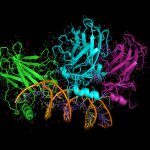Link to Pubmed [PMID] – 9573115
Infect Immun 1998 May; 66(5): 2256-63
Bordetella pertussis fimbriae bind to sulfated sugars such as heparin through the major subunit Fim2. The Fim2 subunit contains two regions, designated H1 and H2, which show sequence similarity with heparin binding regions of fibronectin, and the role of these regions in heparin binding was investigated with maltose binding protein (MBP)-Fim2 fusion proteins. Deletion derivatives of MBP-Fim2 showed that both regions are important for binding to heparin. The role of H2 in heparin binding was confirmed by site-directed mutagenesis in which basic amino acids were replaced by alanine. These studies revealed that Lys-186 and Lys-187 are important for heparin binding of MBP-Fim2, whereas Arg-179 is not required. Peptides derived from H1 and H2 (pepH1 and pepH2) also showed heparin binding activity. Using a series of peptides, in each of which a different basic amino acid was substituted for alanine, we demonstrated that the structural requirements for heparin binding differ significantly among pepH1 and pepH2 peptides. A Pepscan analysis of Fim2 revealed regions outside H1 and H2 which bind heparin and showed that not only basic amino acids but also tyrosines may be important for binding to sulfated sugars. A comparison of the heparin binding regions of Fim2 with homologous regions of Fim3 and FimX, two closely related but antigenically distinct fimbrial subunits, showed that basic amino acids and tyrosines are generally conserved. The major heparin binding regions identified in Fim2 are part of epitopes recognized by human antibodies, suggesting that the heparin binding regions are exposed at the fimbrial surface and are immunodominant. Since B. pertussis fimbriae show weak serological cross-reactivity, the differences in primary structure in the heparin binding regions of Fim2, Fim3, and FimX may affect antibody binding but not heparin binding, allowing the bacteria to evade antibody-mediated immunity by switching the fimbrial gene expressed.


